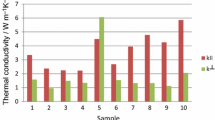Abstract
The preferred orientation of clay minerals dominates the intrinsic anisotropy of shale. We introduce the clay lamination (CL) parameter to the Backus averaging method to describe the intrinsic shale anisotropy induced by the alignment of clay minerals. Then, we perform the inversion of CL and the Thomsen anisotropy parameters. The direct measurement of anisotropy is difficult because of the inability to measure the acoustic velocity in the vertical direction in boreholes and instrument limitations. By introducing the parameter CL, the inversion method provides reasonable estimates of the elastic anisotropy in the Longmaxi shale. The clay content is weakly correlated with the CL parameter. Moreover, the parameter CL is abnormally high at the bottom of the Longmaxi and Wufeng Formations, which are the target reservoirs. Finally, we construct rock physics templates to interpret well logging and reservoir properties.
Similar content being viewed by others
References
Bayuk, I. O., Ammerman, M., and Chesnokov, E. M., 2007, Elastic moduli of anisotropic clay: Geophysics, 72(5), D107–D117.
Berryman, J. G., 1995, Mixture theories for rock properties in Rock Physics and Phase Relations-a Handbook of Physical Constants: Washington, DC,American Geophysical Union.
Carcione, J. M., 2000, A model for seismic velocity and attenuation in petroleum source rocks: Geophysics, 65(4), 1080–1092.
Carcione, J. M., 2001, Amplitude variations with offset of pressure-seal reflections: Geophysics, 61(1), 283–293.
Carcione, J. M., Helle, H. B., and Avseth, P., 2011, Sourcerock seismic-velocity models Gassmann versus Backus: Geophysics, 76(5), N37–N45.
Deng, J. X., Wang, H., Zhou, H., et al., 2015, Microstructure, seismic rock physical properties and modeling of Longmaxi Formation shale: Chinese Journal of Geophysics (in Chinese), 58(6), 2123–2136.
Dong, N., Huo, Z. Z., Sun, Z. D., et al., 2014, An inversion of a new rock physics model for shale: Chinese Journal of Geophysics (in Chinese), 57(6), 1990–1998.
Guo, Z. Q., and Li, X. Y., 2015, Rock physics model-based prediction of shear wave velocity in the Barnett Shale formation: Journal of Geophysics and Engineering, 12, 527–534.
Guo, Z. Q., Li, X. Y., Liu, C., et al., 2013, A shale rock physics model for analysis of brittleness index, mineralogy and porosity in the Barnett Shale: Journal of Geophysics and Engineering, 10, 1–10.
Guo, Z. Q., Li, X. Y., and Liu, C., 2014, Anisotropy parameters estimate and rock physics analysis for the Barnett Shale: Journal of Geophysics and Engineering, 11, 1–10.
Hashin, Z., and Shtrikman, S., 1963, A variational approach to the elastic behavior of multiphase materials. Journal of the Mechanics and Physics of Solids, 11, 127–140.
Hornby, B. E., Schwartz, L. M., and Hudson, J. A., 1994, Anisotropic effective-medium modeling of the elastic properties of shales: Geophysics, 59(10), 1570–1583.
Hu, Q., Cheng, X. H., and Li, J. Y., 2014, Shear velocity prediction for organic shales based on the single aspect ratio model: Progress in Geophysics (in Chinese), 29(5), 2388–2394.
Jiang, M. J., and Spickes, K. T., 2013, Estimation of reservoir properties of the Haynesville Shale by using rock-physics modelling and grid searching: Geophysical Journal International, 195, 315–329.
Mavko, G., Mukerji, T., and Dovrkin, J., 2009, The Rock Physics Handbook (2nd edition): Cambridge University Press.
Ortega, J. A., Ulm, F. J., and Abousleiman, Y., 2009, The nanogranular acoustic signature of shale: Geophysics, 74(3), D65–D84.
Sayers, C. M., 2005, Seismic anisotropy of shales: Geophysical Prospecting, 53, 667–676.
Sayers, C. M., 2008, The elastic properties of carbonates: The Leading Edge, 27(8), 1020–1024.
Schoenberg, M., and Helbig, K., 1997, Orthorhombic media: Modeling elastic wave behavior in a vertically fractured earth: Geophysics, 62(6), 1954–1974.
Slatt, R. M., and Abousleiman, Y., 2011, Merging sequence stratigraphy and geomechanics for unconventional gas shale: The Leading Edge, 30(3), 274–282.
Vernik, L., 1994, Hydrocarbon-generation-induced microcracking of source rocks: Geophysics, 59(4), 555–563.
Vernik, L., and Liu, X., 1997, Velocity anisotropy in shales-A petrophysical study: Geophysics, 62(2), 521–532.
Vernik, L., and Nur, A., 1992, Ultrasonic velocity and anisotropy of hydrocarbon source rocks: Geophysics, 57(5), 727–735.
Wang, Z. J., 2002a, Seismic anisotropy in sedimentary rocks, part 1: A single-plug laboratory method: Geophysics, 67(5), 1415–1422.
Wang, Z. J., 2002b, Seismic anisotropy in sedimentary rocks: part 2 Laboratory data: Geophysics, 67(5), 1423–1440.
Xu, S. Y., and Payne, M. A., 2009, Modeling elastic properties in carbonate rocks: The Leading Edge, 28(11), 66–74.
Zhang, G. Z., Chen, J. J., Chen, H. Z., et al., 2015, Prediction for in-situ formation stress of shale based on rock physics equivalent model: Chinese Journal of Geophysics (in Chinese), 58(6), 2112–2122.
Acknowledgments
We are grateful to reviewers for their careful reviews and constructive suggestions.
Author information
Authors and Affiliations
Corresponding author
Additional information
The research is supported by the Foundation of State Key Laboratory of Shale Oil and Gas Enrichment Mechanisms and Effective Development (No. G5800-16-ZS-KFZY002), the NSFC and SinoPEC Joint Key Project (No. U1663207), and the National Natural Science Foundation of China (No. 41404090).
Liu Xi-Wu, Professor, Received his Ph.D in Geophysics from Chinese Academy of Sciences. He used to be an associate professor in Geophysics at Ocean University of China from 2004 to 2008. He was a postdoctoral researcher at SinoPEC from 2008 to 2010. He is presently at Exploration and Production Research Institute of SinoPEC, mainly focusing on seismic signal processing, reservoir characterization, seismic fracture characterization, and shale oil/gas geophysical prediction.
Rights and permissions
About this article
Cite this article
Liu, XW., Guo, ZQ., Liu, C. et al. Anisotropy rock physics model for the Longmaxi shale gas reservoir, Sichuan Basin, China. Appl. Geophys. 14, 21–30 (2017). https://doi.org/10.1007/s11770-017-0609-x
Received:
Revised:
Published:
Issue Date:
DOI: https://doi.org/10.1007/s11770-017-0609-x




